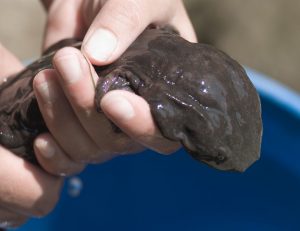Eastern hellbenders found a new home in Big Darby Creek in August. More than 80 of these impressively sized creatures, the largest species of amphibian in Ohio and one of the largest salamanders in the world, settled comfortably into their new habitat.

The reintroduction of this species to Big Darby Creek is a result of a partnership among Metro Parks, the Ohio Hellbender Partnership, Ohio Division of Wildlife, The Ohio State University, the Columbus Zoo and the Omaha Zoo. The last recorded hellbender in Big Darby Creek dates from 1936.
Adult hellbenders average 15-24 inches in length with the largest individual recorded in Ohio measuring over 25 inches and weighing just shy of three pounds. Hellbenders are an endangered species in Ohio, representing one of the rarest amphibians in our state. Only five of Ohio’s 39 species of amphibians have been designated as state endangered.
Hellbenders once ranged throughout 23 counties in Ohio, mostly in the southern and eastern portions of the state in the Ohio River drainage basin. Since 1989, hellbenders have only been recorded in seven Ohio counties. From 1985 to 2009, surveys revealed that the statewide hellbender population declined by 82 percent. Similar declines have been noted throughout their range. Today, the heart of their range in Ohio is a few forested stream systems in eastern Ohio. The single record from Big Darby Creek collected in 1936 represents one of only four Central Ohio records, all prior to 1952.
While the hellbender’s range is often considered to be the center of the Allegheny Mountains, their range actually extends from northern Mississippi and Georgia, northward through the Allegheny Mountains and plateau to southern New York. Isolated populations, located in central Missouri and northern Arkansas, belong to a subspecies known as the Ozark hellbender.

Hellbenders prefer large flat rocks in rivers, streams and larger creeks. Crayfish comprise the staple of their diet, but they will also eat a variety of other aquatic animals. Large fish, other hellbenders, turtles, watersnakes, wading birds, mink, river otters and raccoons prey on hellbenders. Unfortunately, humans probably present the most significant predatory risk to an adult hellbender. Within Ohio’s streams, excessive siltation is the most prevalent environmental threat to hellbender populations. Stable native and reintroduced populations require clean, cool and relatively clear water to survive and reproduce, which makes Big Darby Creek an ideal habitat.
Generally, hellbenders are a shade of brown on top and are often indistinguishable from the color of the river substrate. They may also show color mottling of gray, black, green or orange. Irregular black spots found on their back further aid the camouflage of the animal against the gravelly stream bottom. Hellbenders possess an extensive lateral line system that gives the appearance of the skin being stitched, especially on and around the head. The two small, dark, lidless eyes are located on the top of their head, slightly to the side.
So why reintroduce hellbenders to Big Darby Creek? As part of the preservation, conservation and resource management goals of Metro Parks, protecting endangered, threatened and rare species is a very high priority. Metro Parks has been fortunate to have the support of the residents of Franklin County to acquire, preserve, restore and manage more than 9,200 acres of land along Big and Little Darby creeks Federal and State Scenic Rivers at Battelle Darby Creek and Prairie Oaks Metro parks.
While there may be many reasons for hellbenders’ initial disappearance from Big Darby Creek, over the past 20 years water quality improvements have occurred throughout the watershed creating the opportunity for Big Darby Creek to be a release site. This is also part of a statewide effort to preserve a significant species representing Ohio’s rich natural history and heritage. We are fortunate to have such a high-quality ecosystem in proximity to a metropolitan area to provide the public the opportunity to understand and appreciate a rare species such as this. In the near future, Metro Parks will have a display at the Battelle Darby Creek Nature Center that will house a small hellbender. Stay tuned for its arrival.
JOHN WATTS
Resource Manager
